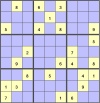Stategies for Declarer Play
Menu

Play Sudoku

Fish Database

Bird Database

Plant Database
Introduction
As declarer it's a lot easier to formulate a plan of attack. After the first card has been placed on the table by the defence you should stop and work out how you intend to make your tricks.
No Trump play is very different to playing in suit contract. Since you have no opportunity to ruff in order to regain the lead at any point, it is standard practice to count your winners, when playing in No Trump.
In a suit contract it is usual to count your losers. You also have the decision to make as to whether or not you want to remove your opponents trump cards first, or try to make a few ruffing tricks first.
You need to take into account the order in which you play the cards, so that you don't end up stuck leading from a hand that holds losers when your other hand contains some winners! Entries, i.e. the ability to be able to cross from one hand to another can be key cards in your plan of attack and defence will do all they can to knock them out. As with defensive play, take care to unblock any suits that could result in your not being able to play your winners.
If having counted your winners or losers you discover that you appear to be short of tricks for your contract, then you need to look into methods of promoting extra tricks. In a trump contract this can involve ruffing losers, or throwing losers away on other losers. In suit and no trump contracts you can look to promote your lower valued cards to be winners later in play, attempt finesses, or play for the oppositions high cards to drop on your own.
Count your Winners
In No Trump play, you should always count your winners and if you have enough to make contract, then don't risk giving the lead away until you have made your contract.
If you can't count enough direct winners to make your contract you need to start looking for extra tricks. Extra tricks can be made by the use of finesses, giving the lead away can often put the opposition into a difficult position with the lead or by end game squeezes, where you force the defenders to make decisions about which suits to discard.
Count your Losers
In a suit contract, you should count your losers and compare that with the number of tricks you're allowed to lose and still make contract.
If you have too many losers, then you need to start looking for places you can throw them away.
Play for the Drop
If you're missing one of the high cards in a suit in which you have a long holding, you should assume an even split when deciding whether or not to play for the drop. For example, if you hold nine cards in a suit, with A,K,10, the even split would be two cards in each of the other hands, meaning that the Q and J will fall on your A and K. If when you play the A either the Q or J falls immediately, assume that it is a singleton and either play a finesse or carry on with the K dependent upon the positon you know belive the J to lie.
Finessing
A finesse is where you play a card lower than what might be necessary to win the trick for sure, in the hope that card that can beat your lower card lies in the wrong hand. For example, say you were to hold the A and Q of a suit and you lead a small card from dummy up to that holding. If the K is held by your right hand opponent, they have to decide whether or not to play it. If they play the K, you take it with your A and your Q is now a winner. If they don't play the K, then you play your Q and win the trick. If you don't have any additional information from the bidding or previous play as to whereabouts the K lies, then it's a fifty fifty gamble.
Given an A,K,J holding and eight cards or fewer in that suit, it is better to play a finesse rather than going for the drop, unless the bidding has told you where the Q lies and there is little chance of the finesse working.
In more desperate situations, where you need even more extra tricks it's possible to play deep finesses. For example you can gamble on your left hand opponent not holding the Q or the J when you hold A,K,10 but this has only a 25% chance of success.
Loser on loser
Having counted your losers in a suit contract, you often find opportunities of discarding a loser from one hand onto a loser led from the other hand. That might sound a little strange, since playing losers means that you've lost the trick, but in fact you have got rid of two of your losers and only lost one trick!
Unblocking
It is frequently critical to ensure that you end up leading from the correct hand. It's a bitter blow to end up in the wrong hand, holding a lot of losers when you're other hand is full of winners but you have no way to reach them.
The general rule for unblocking is to take your winners in the short hand first. For example, if dummy holds Ax and you hold K,Q,J,x,x, then you should win the first round of the this suit with the A so that you can lead the x from dummy across to your long hand.
Further reading
Further useful tips can be found at the following web sites:
